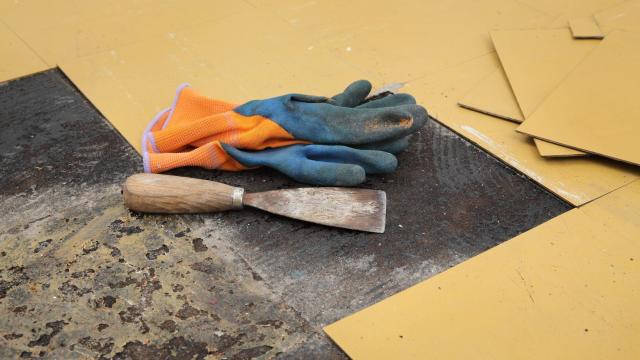When it’s time to remodel your flooring, removing the existing material is usually a pain in the arse. Removing tile or wood flooring probably requires a professional, but vinyl floors aren’t worth that much effort or money. The issue with removing vinyl floors, however, is the adhesive used to secure it to the floor underneath. Depending on the type of flooring it’s attached to, the removal process means scraping glue for hours with warm water or floor stripper. However, there is an easier way to remove the tile, along with the glue — and all you need is one household appliance and one removal tool.
Here’s how to remove vinyl tile from concrete floors without all the heavy scraping.
When should you remove vinyl tile?
The first thing to consider before removing your vinyl flooring is when it was installed. Vinyl flooring made before 1980 could contain asbestos — a dangerous material that was used as a fire protectant in several products before it was discovered as the leading cause of cancers from exposure. Unfortunately, vinyl sheet flooring and linoleum made in the 1960s or 70s have a high probability of containing asbestos, so it’s best to contact a professional before disturbing them so they can be removed safely.
If your flooring is hideous (but doesn’t pose a health threat), you could cover them up, which is an inexpensive option — but comes with its own risks. When there are already several layers of flooring, it can not only potentially prevent doors from closing — it can also compromise the strength of the floor. As contractor site Phillips’ Floors points out: “Nailing or gluing your new floor to the existing one makes your new floor only as strong as the old one. If the old one fails, your new one will go with it.”
So, if you have a concrete floor, removing the vinyl is easy, saves money, and allows you to start with a clean slate rather than building on top.
How to remove vinyl tile from concrete floors
Heavy adhesives and glues can be loosened and removed with an appropriate amount of heat. TikToker deeucci used an iron to remove their old vinyl bathroom tiles. To replicate this, you need a paint scraper and an old iron you no longer need (in case the vinyl damages the iron). Fill the iron with water and set it to its highest heat setting. Let the iron sit directly on the tile for 30 to 40 seconds to melt the glue and loosen the tile. Next, take your paint scraper and gently leverage the tile up from the floor. You may need to cut a corner of the first tile to get leverage, but you won’t need to scrape at that glue for days after removing the tile.
Watch deeucci’s video for an example of this method at work.
If any glue residue does stick around, you can use mastic and adhesive remover and a mop or scrub brush to clean the floors. The website for adhesive product Loctite recommends mixing a small amount of ammonia with dish detergent to scrub away any remaining glue.

Leave a Reply
You must be logged in to post a comment.